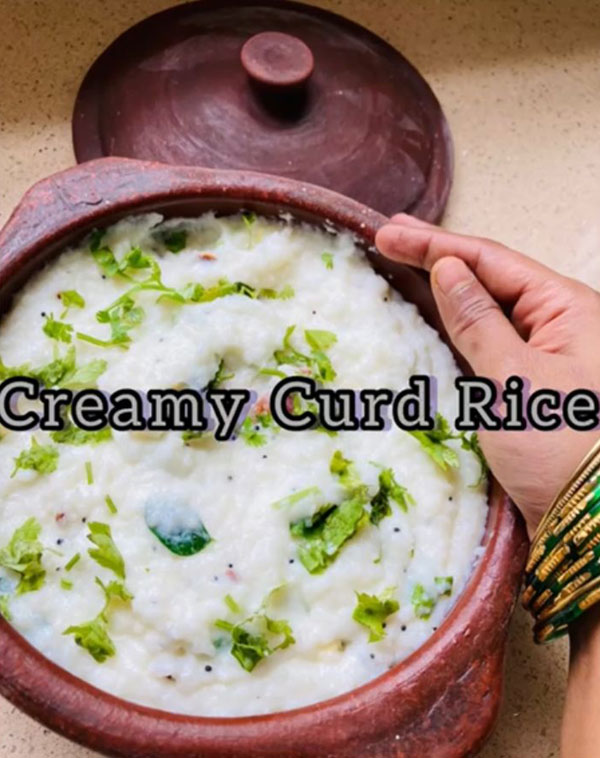Curd Rice
Curd rice is just that, a healthy, light meal option that is the combination of two very healthy ingredients, curd and rice. This dish is a rich source of probiotics making it beneficial for promoting digestive health.

Curd Rice is great even in maintaining the balance of gut-friendly bacteria. It can improve our digestive tract. It also reduces acne by keeping the gut healthy.
It is one of those dishes that pack in simplicity along with an adequate amount of nutritional content and the best fibre-rich whole food for all age groups.
Ingredients
- 1 cup rice
- 2 cups milk
- 1/4 cup curd
- 1 tsp mustard seeds
- 3-4 green chilies
- 3-4 curry leaves
- ½ cup Urad dal
- Chopped ginger
- Chopped coriander leaves
Method
- Rinse the rice a couple of times in water.
- Pressure cook the rice with 2 cups of water for 4 to 5 whistles.
- Open the lid once the pressure settles. Mash the rice with a ladle or masher.
- Add milk and mix without any lumps.
- Add curd and mix.
- In a pan a heat little oil and temper with mustard seeds, urad dal, green chillies, and ginger curry leaves.
- Pour over the rice.
- Add salt.
- Garnish with chopped coriander and serve.
Always use fresh cooked & cooled rice. For a healthier whole grain option, use brown rice, rolled oats, or even broken wheat to make this dish.
Make sure the grains are soft cooked and mashed well before adding the curd to it. The rice turns hard when curd is added to it without mashing well.

Recipe contributed by Kauvery well-wisher Mrs. Lavanya Mukil
Check out Kauvery Hospital’s Facebook page.
Swayed by Sweet Potato
The humble sweet potato, in all its weird and wobbly innocuousness, often gets a poor rep. Especially when pitted against, rather unfairly, the universally loved potato. While madhura kizhangu puzhukku and sweet potato fries have persuaded many to switch camps, it doesn’t exactly top the list of favourite vegetables for too many. But, maybe it should, given that there’s plenty more to this unassuming tuberous root, says Yamini, clinical dietician, Kauvery Hospital.

“There’s a misconception that roots and tubers are not to be consumed in large quantities because of their starch content. But, when it comes to the nutritional value, the other components like micro-nutrients also have to be kept in mind. For this, sweet potato can be consumed,” explains Yamini.
There are two types of the sweet potato. “The one which is available in India is the orange-pinkish one; the other one is purple and not commonly available here. But both of them have the same properties and are very good for your health. It is anti-inflammatory, reduces free radicals and boosts your immune,” she details.
Addresses anaemia
It is very rich in ascorbic acid, fulfilling the vitamin C part. It’s also a good source of iron. If cooked with jaggery, the nutritional anaemia can be treated.
Potassium power
Sweet potato is a rich source of potassium. This can help manage high blood pressure, its water retention properties can regulate muscle contractions and prevent kidney stones too.
Starchy but good
Even though it is a starchy vegetable with a minimal amount of carbohydrates, it minimises the absorption of sugar in the body, thanks to its good fibre content both soluble and insoluble. So, even diabetic patients can consume it once or twice a week if their sugar level is under control.
Metabolism matters
The high fibre content also helps in maintaining gut health. It enhances the growth of beneficial bacteria in your stomach; this way, it can help treat infective diarrhoea, irritable bowel syndrome and other digestive disorders. It helps in weight gain, but portion size is the key and it has to be taken appropriately.
Brain food
It is a very good source of choline an essential nutrient that enhances the brain function.
Vitamin storehouse
Sweet potato is also very rich in beta carotene, which is the precursor for vitamin A. This vitamin is very essential in all stages of life, playing a vital role in eye health.
Rich in antioxidants
It is filled with anthocyanins with antioxidant properties. Hence, it has to be included in everyday diet.
Consumption
A 100 grams of baked sweet potato offers 51 grams of carbohydrates, 4 grams of protein, 6 to 7 grams of fibre and very minimal fat. Otherwise, it is also rich in vitamin C and B6, magnesium, etc.
The best way to consume sweet potato is to steam/bake it and have it with jaggery or slight seasoning. It can also be made as a regular south Indian curry or poriyal, with tomato and onions and spices.
“Sweet potato is not given much importance on the plate. But, you should try to include it regularly in your diet. In layman terms, it just looks like the pancreas – the shape of the tuber. And Mother Nature has given it all these properties too. That depicts that it is very good for your vital organ, pancreas,” she concludes.
Sweet Potato Roli
Steam the sweet potato until tender, then mash it and combine it with a small amount of grated coconut or jaggery powder. Mix the ingredients thoroughly and shape the mixture into small balls.
Gently knead wheat flour, roll it out into a thin sheet, and place the sweet potato balls on it. Ensure that the edges are covered, and lightly dust it with all-purpose flour. Roll it into a paratha.
In a pan, shallow fry the paratha until both sides are nicely cooked. You can use either ghee or oil as the cooking medium.
For diabetic individuals, jaggery can be replaced with dhal or coconut as a healthier alternative.

Ms Yamini Prakash, MSc., RD
Lead – Clinical Dietician,
Kauvery Hospital Chennai

